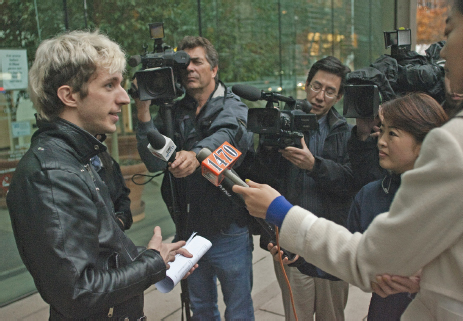Money Out
Printed Page 81
Like any other enterprise, a newspaper has to spend money to fulfill its mission. Its costs include overhead (such as rent and utilities), salaries and wages, marketing and sales, and any investments in wire services or feature syndication required to offer content for readers.
Salaries and Wages
A major expense for most newspapers comes in the form of salaries and wages paid to the various editors and reporters working for the paper, though in the last five to ten years newspapers have shrunk not only their newshole but the size of their reporting staffs. By various estimates, depending on the newspaper, 20 to 40 percent fewer reporters worked in newsrooms in 2010 than in 1990. Most large papers have a publisher and an owner, an editor in chief and a managing editor in charge of the daily news-gathering and writing processes, and assistant editors and news managers running different news divisions. These key divisions include features, sports, photos, local news, state news, and wire service containing much of the day’s national and international news reports.
Reporters work for editors. General assignment reporters handle all sorts of stories that might emerge—or “break”—in a given day. Specialty reporters are assigned to particular beats (police, courts, schools, local and national government) or topics (education, religion, health, environment, technology). On large dailies, bureau reporters also file reports from other major cities. In addition, large daily papers feature columnists and critics who cover various aspects of culture, such as books, television, movies, and food.

By the early 2000s, when digitization of news content was in full swing, many newspapers employed a separate staff for their online operations, even though most of these operations were losing money. Nowadays, the economic downturn and industry consolidation has led to reductions in newsroom headcount, as merging papers laid off redundant personnel and cut additional staff to reduce costs. In 2001, the American Society of Newspaper Editors (ASNE) reported 56,400 reporters in newsrooms; only about 41,600 were working by late 2011.9 Fewer and fewer papers now maintain bureaus outside their own city limits. Some smaller daily papers have even quit sending reporters to cover state government. The Los Angeles Times, the Chicago Tribune, the Baltimore Sun, and the Hartford Courant—all owned by the Tribune Company—all closed their independent bureaus in 2008.10
All these trends have put a strain on the remaining reporters and editors, who are increasingly being asked to develop stories in multiple formats with fewer personnel. The downside of this money-saving technique means that far fewer versions of stories are being produced as readers become more reliant on a single version of a news report.
Wire Services and Feature Syndication
To provide adequate coverage of important events and deliver high-quality reporting, many newspapers rely on wire services and syndicated feature services to supplement local coverage by their own reporters and writers. A few major dailies, such as the New York Times, run their own wire services, selling their stories to other papers to reprint. Other agencies, such as the Associated Press (AP), United Press International (UPI), and Reuters (based in London) have hundreds of staffers stationed throughout major U.S. cities and world capitals. They submit stories, photos, and videos each day for distribution to newspapers, newscasts, and online sites across the country and sometimes internationally.
Daily papers generally pay monthly fees for access to all wire stories. Although they use only a fraction of what’s available over the wires, editors carefully monitor wire services each day for important stories and ideas for local angles.
In addition, newspapers may contract with feature syndicates, such as United Features and Tribune Media Services, to provide work from the nation’s best political writers, editorial cartoonists, comic-strip artists, and self-help columnists. These companies serve as brokers, distributing horoscopes and crossword puzzles as well as the columns and comic strips that appeal to a wide audience; however, with the downsizing of newspapers in terms of space, most papers today offer far fewer syndication services than in the 1990s.